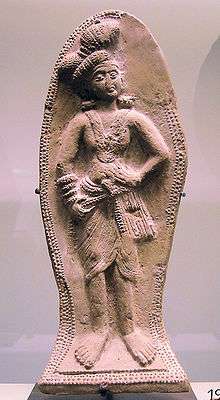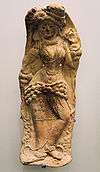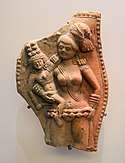Chandraketugarh
|
| |
 Shown within West Bengal | |
| Location | West Bengal, India |
|---|---|
| Coordinates | 22°41′52″N 88°41′18″E / 22.69778°N 88.68833°ECoordinates: 22°41′52″N 88°41′18″E / 22.69778°N 88.68833°E |
| Type | Settlement |
| History | |
| Founded | 400 BC to 800 BC |
| Abandoned | 12th century AD |
Chandraketugarh is an archaeological site located beside the Bidyadhari river, about 35 kilometres (22 mi) north-east of Kolkata, India, in the district of North 24 parganas, near the township of Berachampa and the Harua Road railhead.
Years of excavation within 1957-68 (conducted by Asutosh Museum of Indian Art) have revealed relics of several historical periods,[1] although the chronological classification of the relics remains incomplete.
According to some historians, the Chandraketugarh site and surrounding area could be the place known to ancient Greek and Roman writers as having the same name as the river Ganges (Γάγγης)[2] sometimes referred to as 'Gangaridai'.
Legend
The legend of Khana (A medieval Bengali language poet and legendary astrologer between the ninth and 12th centuries AD, also named Lilavati elsewhere) centers around her association with Chandraketugarh (here, a mound has been discovered amongst ruins with the names of Khana and Mihir associated with it) and that she was the daughter-in-law of the famous astronomer and mathematician, Varāhamihira (505 – 587), also called Varaha or Mihira, a jewel among Chandragupta II Vikramaditya's famed Navaratna sabha.
It is widely believed that Khana was Varahamihira's daughter-in-law, and an accomplished astrologer, becoming thereby a potential threat to Varahamihira's scientific career. However, she exceeded him in the accuracy of her predictions, and at some point, either her husband (or father-in-law) or a hired hand (or possibly Khana herself under great duress) cut off her tongue to silence her prodigious talent.
There is another heritage mosque in the name of Pir Gorachand (an Arab missionary of 14th century named Syed Abbas Ali).[3][4][5]
History
Chandraketugarh is thoughtby whom? to be a part of the ancient kingdom Gangaridai that was first described by Ptolemy. The history of Chandraketugarh dates back to almost the 3rd century BC, during the pre-Mauryan era. Artefacts suggest that the site was continuously inhabited and flourished through the Shunga-Kushana period, onwards through the Gupta period and finally into the Pala-Sena period. Archaeological studies suggest that Chandraketugarh was an important town and a port city. It had a high encircling wall complete with a rampart and moat. The residents were involved in various crafts and mercantile activities. Although the religious inclinations of the people are unclear, hints of the beginning of some future cults can be seen in the artefacts. Some of the potteries carry inscriptions in Kharoshthi and Brahmi scripts.
| Period | Dynasty | Year |
|---|---|---|
| Period I | Maurya | 300-200 BC |
| Period III | Shunga | 200 BC - 50 AD |
| Period IV | Kushan | 50-300 AD |
| Period V | Gupta | 300-500 AD |
| Period VI | Post-Gupta | 500-750 AD |
| Period VII | Pala-Chandra-Sena | 750-1250 AD |
After these periods, there was no such example of any other civilization on the ruin of Chandraketugarh.
Excavated Archeological Objects



Chandraketugarh features many examples of terracotta art, displaying an unusual degree of precision and craftsmanship. These plaques are comparable to those found at other better-known sites such as Kaushambi and Ahichhatra. The terracotta plaques from these sites often carry similar motifs executed in nearly identical fashion. This similarity suggests an established communication link and common cultural heritage among these sites.
Finds include Northern Black Polished Ware (NBPW) relics, later wares dated from about 400 BC to 100 BC and approximately contemporary with the Maurya period, as well as from the more recent Kushanas and Gupta periods.
A large number of silver punch-marked coins and a few gold coins have been unearthed from Chandraketugarh, including a gold coin of Chandragupta-Kumardevi. A large number of semi-precious stone beads were also found here, along with items made of ivory and bone. Even a few wooden objects have survived. [1]
See also
References
- 1 2 3 Dr. Gaurishankar de & Prof. Subhradip de, Prasanga: Pratna-Prantar Chandraketugarh, First Edition: 2013, ISBN 978-93-82435-00-6
- ↑ "Merchants, Merchandise and Merchantmen in the Western Seaboard of India: A Maritime Profile (c. 500 BCE-1500 CE)." Ranabir Chakravarti. In: History of Science, Philosophy and Culture in Indian Civilization, Vol. VIII (1), (2012) Om Prakash (Ed.), Centre for Studies in Civilization, Delhi, pp. 69-70.
- ↑ Mitra, Satish Chandra. Jashor Khulnar Itihash Volume I. Deys Publishing, p. 482.
- ↑ Chakraborty, Dr. Barun Kumar (ed) (2007). Bangiya Loksanskriti Kosh. Aparna Book Distributors (Publishing Division), p. 143.
- ↑ Ghosh, Binay (1980). Paschimbanger Sanskriti Volume III. Prakash Bhavan, p. 168.
- Chandraketugarh : A Treasure House of Bengal Terracottas - Enamul Haque. Dhaka, The International Centre for Study of Bengal Art, 2001, 416 p., 678 illustrations including 400 in colour, figures, plates, maps, ISBN 984-8140-02-6.
- Chandraketugarh : A Lost Civilization - Gourishankar De and Shubhradip De. Kolkata, Sagnik Books, 2004, 109 p., 34 photos,
External links
| Wikimedia Commons has media related to Shunga Empire. |
| Wikimedia Commons has media related to Chandraketugarh. |
- Banglapedia article
- Website concerning Chandraketugarh
- Photos
- Interview with Prof. Joachim K. Bautze
- Timeline of excavation with photos
- collection of relics
- Chandraketugarh
- A plaque of Chandraketugarh
- A travel article on Chandraketugarh by Rangan Datta
- A Travel Article on Archeological Sites near Calcutta by Rangan Datta
- Rangan Datta's Home Page
